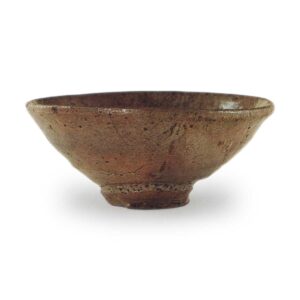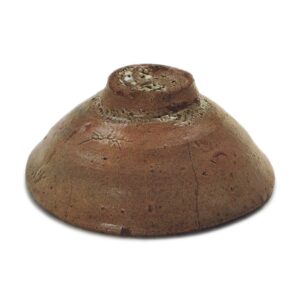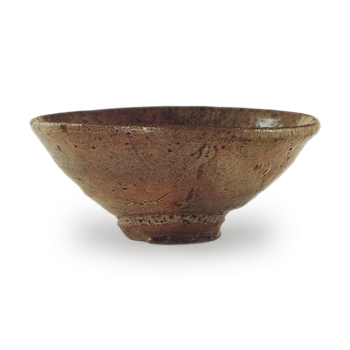

Meibutsu
Height: 5.8-6.1cm
Diameter: 13.75-14.0cm
Outer diameter of foot ring: 4.55-4.8cm
Height of foot ring: 1.25-1.4cm
This name comes from the fact that it was once owned by Masuya, a wealthy merchant in Sakai.
The overall form of the tea bowl is compact and small, and the height is also slightly low, so it can be said that it is a tea bowl similar to the Koboku tea bowl from the Aoido period. However, the marks of the potter’s wheel from the foot to the rim are quite strong, and in particular, the foot is carved out with a sense of power, and it has a varied tone with high and low points on the left and right.
The side of the bowl, from the foot to the rim, is not the straight lines characteristic of Aoido ware, but rather has a slightly bowl-shaped curve that widens out, and there is also a crack in the waist. Although it is called Aoido ware, the overall color is not very blue, and the glaze is not very thick. The kaaragi (flower-patterned) design on the inside and outside of the foot ring is clearly visible, but the kaaragi on the inside of the foot ring is particularly attractive.
The interior of the bowl is covered in fairly rough craquelure, and the glaze is a vivid loquat-colored with hints of blue and red. Another highlight is the clear wheel marks that run around the inside, and there are four of these marks left. The overall glaze is soft and smooth, and the bowl has a rich appearance, but the main highlight of this bowl is the way the work has been done from the foot to the rim.
Incidentally, in a report on a visit to Kaga by the tea master Seika Matsuyama in the Meiji era, it is written that “the reddish glaze is small on the foot ring, and there is a latticework pattern on the inside, and the latticework pattern on the inside is like a latticework pattern on the inside, and the latticework pattern on the inside is like a latticework pattern on the inside, and the latticework pattern on the inside is like a latticework pattern on the inside, and the latticework pattern on the inside is like a latticework pattern on the inside, and the latticework pattern on the inside is like a latticework pattern on the inside, and the ‘ and praises it.
On the inside of the paulownia wood box, there is a label on the front of the lid that says ‘Masuya Ido’, and on the back of the lid, there is a gold-painted label that says ‘Masuya Ido’, but the author is unable to make out the writing. In the “Gogaku-shu” (Collected Works) of Tanimatsuya Toda Yashichi (Rogen), it is written, “This is a bowl that was made in the modern style, and was made by the Kansai Kameda family, who obtained it from the Kansai Kamei family, who obtained it from the Kansai Kamei family, who obtained it from the Kansai Kamei family, who obtained it from the Kansai Kamei family, who obtained it from the Kansai Kamei family, who obtained it from the Kansai Kamei family, who obtained it from the Kansai Kamei family, who obtained it from the Kansai K After that, it was owned by the Hirase family, and then sold to the Noh family in California after being requested by the Hirase family, and then sold to the Noh family in Kyoto after being requested by the Noh family. It is said that it was sold to the Toda family at a high price of 400 yen at the auction in March 1886. In the auction held in August 1890, it was sold to Kunimatsu, a Kyoto-based dealer, for 150 yen, and then passed into the hands of the Ishiguro family of Kanazawa, and later into the collection of Mitsui Takayasu.
The history of the Masuya family is not well known, and it is not clear when it became a part of the Masuya family.



